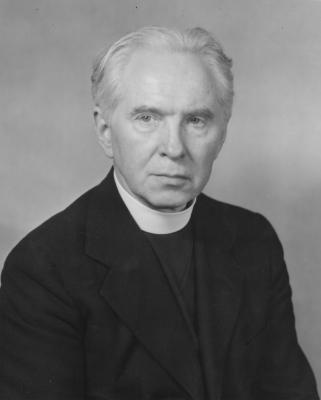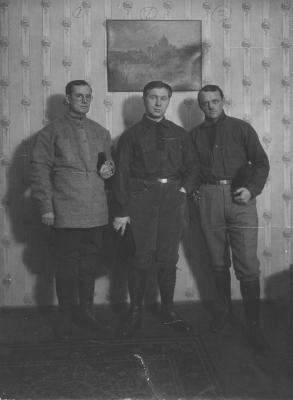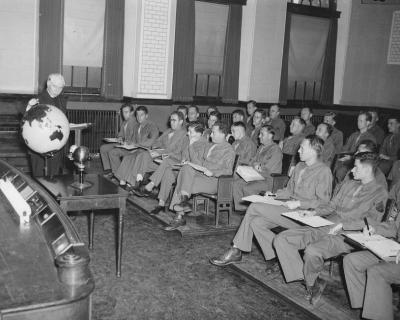Fr. Edmund A. Walsh, S.J., was the founder and longtime regent of Georgetown's School of Foreign Service. Walsh spent 40 years at Georgetown and played a role in several significant international events, including relief for the Russian famine of the early 1920s and the Nuremberg trials.
Early Georgetown career
Walsh was only 16 when he joined the Jesuits1 and was eventually assigned to Georgetown before his ordination. In January 1910, Walsh helped revive Georgetown's Dramatic Association2, which put on its first play in years that same month3. Under Walsh's leadership, the Dramatic Association continued to put on plays in the following years. Walsh also helped judge a sophomore oratorical contest in 1912, which Bernard S. Brady won with a speech on socialism.
Walsh's first stay at Georgetown was brief, as he soon left for Innsbruck, Austria to study theology and then left Europe upon the outbreak of World War I4. He returned to Georgetown and eventually served as the dean of science5. Walsh was ordained in 19166. Once the US entered the war, Walsh was appointed a New England director of the Student Training Corps7, granted the rank of major, and stationed at Harvard8.
Founding of the School of Foreign Service
In the aftermath of World War I, Georgetown established its School of Foreign Service. Walsh, only 33 at the time, was selected as the new school's regent9. In an address to the American Manufacturers Export Association shortly after the SFS's founding, Walsh described the school as "the West Point for foreign service and a national clearing-house of foreign trade information"10. Classes were initially held in the evening from 6:30-9:4511. A 1939 Hoya article identifies Harry Sandager, a future Republican congressman from Rhode Island, as the SFS's first student12. The SFS's courses initially focused on the following topics: languages, economics and commerce, law and political science, and shipping13.
Papal Relief Mission
In 1922, Pope Pius XI selected Walsh to lead the Pontifical Relief Expedition to Russia14. In a letter to Fr. Creeden published in the Hoya, Walsh explained that his expedition aimed to feed 40,000 children in Crimea amidst an extreme famine15. He returned to Georgetown in February 192416, criticizing the state of Soviet education and the persecution of priests at a banquet17. Walsh took his final Jesuit vows in March 1924, receiving a message from Pope Pius XI praising his work in Russia18. Later that year, he joined the Council on Foreign Relations19.
Return to Georgetown Georgetown (1924-1943)
Walsh left briefly for Rome toward the end of the 1927 academic year. As president of the Catholic Near East Association, he sought to bring students from Russia and neighboring countries to Georgetown; he also planned to meet with Pope Pius XI on his trip20. In a 1929-30 trip to Europe, Walsh met with the pope twice21. In a 1936 lecture, Walsh argued that joining the Catholic clergy requires one to abstain from politics, remarks interpreted as a reference to political controversy over Rev. Charles Coughlin's often anti-Semitic radio show22. However, Walsh told a Hoya writer that his remarks had been prepared in advance of Coughlin's insults targeted at Rep. John O'Connor23.
In a 1939 lecture, Walsh argued that Nazism "could easily lead to a conflict such as modern history has not yet seen"24. After the US's entry into World War II, Walsh embarked on a lecture tour to various Army camps, giving talks on "Democracy and World Revolution"25. He met with Jan Karski, then a courier for the Polish resistance, shortly before Karski's July 1943 meeting with President Roosevelt26. Later that year, Walsh was a prominent speaker at an Army exhibition by the Washington Monument27.
Nuremberg Trials
In the aftermath of Nazi Germany's defeat, Walsh assisted the Allies with preparations for the Nuremberg trials. Serving as an aide to Justice Robert H. Jackson28, the chief American prosecutor at Nuremberg, Walsh was assigned to interrogate Gen. Karl Haushofer, an academic who had purportedly influenced Hitler's thought by promoting the concept of "lebensraum"29. While the Allies had hoped to prosecute Haushofer, his fragile medical condition led them to change Walsh's assignment to an informal interrogation30.
Walsh recounted that one interrogation session consisted of "Haushofer evading or mitigating the charges, the interrogator citing documents by chapter and verse"31. Haushofer insisted that Hitler and the Nazis had distorted his views; Walsh then demanded that Haushofer issue a public statement to that effect, which Haushofer agreed to do32. Months after he submitted the statement, Haushofer and his wife died by suicide at their home in Bavaria33. Reflecting upon his experience interrogating Haushofer, Walsh concluded that "Haushofer's contribution to the Nazi revolution was considerable"34.
Walsh returned to Georgetown from the Nuremberg trials on July 6, 194635.
Later Years at Georgetown (1947-1956)
Walsh's annual lecture series was postponed for five years due to World War II, resuming in 194736.
In 1948, Walsh published Total Power - A Footnote to History, which The Hoya described as "an analysis of revolution"37. The book featured insights from Walsh's experiences in Russia, at the Nuremberg trials, and in postwar Japan38. Walsh published his final book, Total Empire - The Roots and Progress of World Communism, in 195139.
While Walsh had played an active role in campus life, his profile at Georgetown decreased as he encountered health issues. Walsh suffered a stroke in November 195240. He then suffered what The Hoya described as a "mild stroke" in 195341.
Shortly before his death in 1956, Georgetown created the Edmund A. Walsh lecture series42. The first lecture was given by Irish prime minister John Costello43. Walsh died of a brain hemorrhage on October 31, 1956 at the Georgetown University Hospital44.
Russia and Communism
Fr. Walsh was a fierce opponent of communism and took a lifelong interest in Russia. In 1928, he published a series of articles in The Atlantic, expanded upon in his book The Fall of the Russian Empire, examining the collapse of the tsarist regime45. Walsh conducted a series of lectures on Russia the following year in Gaston Hall46. In 1931, Walsh published The Last Stand, analyzing the Soviet Union's Five Year Plan47.
For much of his time at Georgetown, beginning after his return from Russia, Fr. Walsh's annual lecture series focused on Soviet Russia. The lectures were deeply critical of communism and often highlighted its incompatibility with liberal democracy. Walsh was especially passionate about religious persecution in the Soviet Union, arguing in a 1930 lecture that no government could deny its citizens their right to worship48.
While Walsh warned against clerical involvement in politics, he felt compelled to criticize President Roosevelt's October 1941 comments that stated freedom of religion existed in the USSR49. Walsh pointed out that worshippers in the Soviet Union could not "exercise some of the most important functions of religious freedom"50. Walsh's obituary in the New York Times described him as a "long-time leader in the fight against world communism"51.
Legacy
Walsh is best remembered today as the founder and namesake of the Edmund A. Walsh School of Foreign Service. Starting with only evening classes, the SFS is now highly selective and is one of the US's leading international affairs schools. Even at its founding, the SFS was groundbreaking - the State Department's Foreign Service was only established in 1924, several years after the SFS52.
Walsh also attracted notable faculty members to the SFS. Senator David I. Walsh (D-MA) joined the SFS faculty in 1927, teaching a Practical American Government course53. Fr. Walsh later provided financial aid for Jan Karski, an early Holocaust witness, to receive his doctorate at Georgetown54. Upon Karski's graduation, Walsh hired him as a full-time instructor in the SFS55.
The Walsh Lecture Series, named for Fr. Walsh, ran until approximately 197056. Notable speakers included Sen. Mike Mansfield (D-MT)57 and Henry Cabot Lodge, former Republican senator from Massachusetts and Ambassador to the United Nations58.
Georgetown's Edmund A. Walsh Building, opened in 1958, is named after Fr. Walsh59. The Walsh Building housed the SFS until 1982, when it moved into the Bunn Intercultural Center60. Today, the Walsh Building hosts a variety of classes and features the Maria and Alberto de la Cruz Art Gallery61.
- 1"Foreign Service Head Has Varied Career." The Hoya. 20 November 1925.
- 2"The Revival of the Dramatic Association." The Georgetown College Journal. January 1910.
- 3Dailey, Vincent. "A Thespian Triumph." The Georgetown College Journal. February 1910
- 4"Fr. Walsh Fries Eggs in Russia." The Hoya. 10 May 1923.
- 5"Fr. Walsh Fries Eggs in Russia." The Hoya. 10 May 1923.
- 6"Father Edmund Walsh Dies." The Hoya. 8 November 1956.
- 7"Fr. Walsh Fries Eggs in Russia." The Hoya. 10 May 1923.
- 8"President of Yard Reviews World War I Campus Activity." The Hoya. 10 December 1941.
- 9"School of Foreign Service pro patria per orbis concordiam." Georgetown College Journal. March 1919.
- 10"School of Foreign Service pro patria per orbis concordiam." Georgetown College Journal. November 1919.
- 11"School of Foreign Service pro patria per orbis concordiam." Georgetown College Journal. March 1919.
- 12"Father Walsh Meets Friend And Ex-Pupil At Fraternity Dinner." The Hoya. 1 February 1939.
- 13"School of Foreign Service pro patria per orbis concordiam." Georgetown College Journal. March 1919.
- 14"Father Walsh Reports Work In Russia," The Hoya, 26 October 1922.
- 15"Father Walsh Reports Work In Russia," The Hoya, 26 October 1922.
- 16"Father Walsh Speaks On Russia," The Hoya, 14 February 1924.
- 17"Rev. E.A. Walsh Is Banquetted," The Hoya, 7 March 1924.
- 18"Fr. E.A. Walsh Is Honored By Pope." The Hoya. 3 April 1924.
- 19"F.S. Regent Given Honor." The Hoya. 3 October 1924.
- 20"Regent Of Foreign Service School Sails." The Hoya. 12 May 1927.
- 21"Fr. Walsh Hits Red Activities." The Hoya. 29 January 1930.
- 22"Fr. Edmund Walsh Continues Lectures." The Hoya. 26 February 1936.
- 23"Fr. Edmund Walsh Continues Lectures." The Hoya. 26 February 1936.
- 24"Nazi Worship of Race and Blood Old Superstition, Fr. Walsh Says." The Hoya. 8 March 1939.
- 25"Father Walsh Gives Lectures to Score Of U.S. Army Camps." The Hoya. 13 May 1942.
- 26Wood, E. Thomas and Stanislaw M. Jankowski. "Karski: How One Man Tried to Stop the Holocaust." New York, Wiley, 1994, p. 205.
- 27"'Back The Attack' Thrills Thousands; 'War Bonds Bringing Victory,' Theme." The Hoya. 6 October 1943.
- 28"Fr. Walsh to Return Feb. 21 From Seven Month European Mission for War Dept." The Hoya. 15 February 1946.
- 29Walsh, Edmund A. "The Mystery of Haushofer." Life, 16 Sep. 1946, 107-120.
- 30Walsh, Edmund A. "The Mystery of Haushofer." Life, 16 Sep. 1946, 107-120.
- 31Walsh, Edmund A. "The Mystery of Haushofer." Life, 16 Sep. 1946, 107-120.
- 32Walsh, Edmund A. "The Mystery of Haushofer." Life, 16 Sep. 1946, 107-120.
- 33Walsh, Edmund A. "The Mystery of Haushofer." Life, 16 Sep. 1946, 107-120.
- 34Walsh, Edmund A. "The Mystery of Haushofer." Life, 16 Sep. 1946, 107-120.
- 35"Fr. Edmund Walsh Returns from Trial Of War Criminals." The Hoya. 24 July 1946.
- 36"Nurenberg Trials Are Subject Of Lectures By Fr. Walsh." The Hoya. 14 February 1947.
- 37Burns, George. "'Total Power', Regent's New Book, Out This Week." The Hoya. 21 May 1948.
- 38Burns, George. "'Total Power', Regent's New Book, Out This Week." The Hoya. 21 May 1948.
- 39"Father Edmund Walsh Dies." The Hoya. 8 November 1956.
- 40"Fr. Walsh Stricken." The Hoya. 11 December 1952.
- 41"Bulletin." The Hoya. 12 March 1953.
- 42"Lecture Series Inaugurated By Irish Prime Minister." The Hoya. 15 March 1956.
- 43"Lecture Series Inaugurated By Irish Prime Minister." The Hoya. 15 March 1956.
- 44"Rev. E.A. Walsh of Georgetown U." The New York Times. 1 November 1956.
- 45"' The Fall Of The Russian Empire', Father Walsh's Book, Published." The Hoya. 17 May 1928.
- 46"Dr. Walsh Speaks Tonight On Russia." The Hoya. 31 January 1929.
- 47"Fr. Walsh's New Book On Russia Issued." The Hoya. 25 March 1931.
- 48"Fr. Walsh Scores Red Persecution." The Hoya. 19 November 1930.
- 49"Doctor Walsh Hits Soviet Official; Denies Russian Religious Freedom." The Hoya. 8 October 1941.
- 50"Doctor Walsh Hits Soviet Official; Denies Russian Religious Freedom." The Hoya. 8 October 1941.
- 51"Rev. E.A. Walsh of Georgetown U." The New York Times. 1 November 1956.
- 52Walsh School of Foreign Service, A Legacy of Service. https://sfs.georgetown.edu/mission/legacy/.
- 53"F.S. School Will Open October 1st." The Hoya. 15 September 1927.
- 54Curry, Andrew and Clay Risen. "Testimony Unheard, Life Unsung: The Tale of Georgetown's Jan Karski." The Hoya. 24 February 1998.
- 55Curry, Andrew and Clay Risen. "Testimony Unheard, Life Unsung: The Tale of Georgetown's Jan Karski." The Hoya. 24 February 1998.
- 56"Central Speakers Program Among Lecture Suggestions." The Hoya. 12 December 1968.
- 57"Mansfield Slated To Talk on Foreign Policy; Israel's Abba Eban Postpones Lecture." The Hoya. 21 February 1957.
- 58"Big Crowd Hears Ex-Senator Lodge In Walsh Lecture." The Hoya. 17 January 1963.
- 59"President To Attend Oct. 18 Dedication of Walsh Building." The Hoya. 18 September 1958.
- 60Mathias, Richard. "Intercultural Center Opens, Holiday Sept. 24." The Hoya. 27 August 1982.
- 61Department of Art and Art History, Celebrating the Inaugural Year of Our New Maria & Alberto de la Cruz Art Gallery: A Year in Review. https://art.georgetown.edu/news/celebrating-the-inaugural-year-of-our-new-maria-alberto-de-la-cruz-art-gallery-a-year-in-review/.




